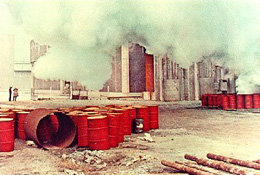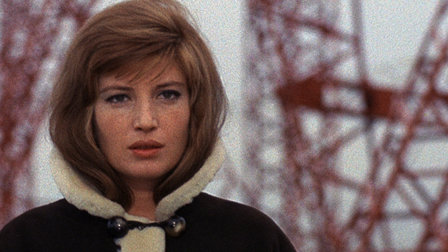Andrew Rostan was a film student before he realized that making comics was his horrible destiny, but he’s never shaken his love of cinema. Every two weeks, he’ll opine on either current pictures or important movies from the past.
Right now, besides writing about movies for this site, I am working on my first screenplay since moving here from Los Angeles. It’s a script that I am immensely proud of but could never have imagined telling when I first set out on my path as a writer. Why that is, and why I write about the films I do on here, requires a small story.
A Film I’d Never Seen
I grew up in a Northeast Ohio suburb: very middle-class, very white, very Christian, and very hard to find elements outside these parameters. One of the last places to look, ironically enough, was our high school library, with its bulk of standard YA fair that had only gradually been updated since the 1980s.
Yet in these stacks I found a book that quietly changed my life. Having already determined that writing, particularly screenwriting, was my ambition, I dove into Boardman High School’s minuscule section on the cinema and discovered Stanley Kauffmann’s A World on Film. Kauffmann was once chief critic for The New Republic, and this volume collected his reviews from 1958 to 1965. A World on Film enthralled me. Kauffmann trashed big-budget Hollywood spectacles and instead reveled in cinema from France, Italy, Sweden, and Japan…movies I could never find at the local Blockbuster and Hollywood Videos.
 The stories Kauffmann described were far from the Disneys, madcap comedies, and sci-fi/action mélanges I’d hitherto been raised on: they were stories of real adults dealing with realistic issues, from the trials and tribulations of romance to pondering the nature of existence. Near the end of the book, Kauffmann flew into ecstasy over Red Desert, the 1964 film directed and co-written by Michelangelo Antonioni; in particular, the critic rhapsodized over how the director used color unlike anyone before, to emphasize and heighten the drama and ideas of the story. Having spent my whole life watching color movies, I didn’t immediately appreciate Kauffmann’s point, but this review, along with some of the ones accompanying it, was the first step in me breaking away from my preconceived notion of what movies were—bright, kinetic affairs with happy endings—and forming a more all-encompassing definition, and with that, my own voice as a writer.
The stories Kauffmann described were far from the Disneys, madcap comedies, and sci-fi/action mélanges I’d hitherto been raised on: they were stories of real adults dealing with realistic issues, from the trials and tribulations of romance to pondering the nature of existence. Near the end of the book, Kauffmann flew into ecstasy over Red Desert, the 1964 film directed and co-written by Michelangelo Antonioni; in particular, the critic rhapsodized over how the director used color unlike anyone before, to emphasize and heighten the drama and ideas of the story. Having spent my whole life watching color movies, I didn’t immediately appreciate Kauffmann’s point, but this review, along with some of the ones accompanying it, was the first step in me breaking away from my preconceived notion of what movies were—bright, kinetic affairs with happy endings—and forming a more all-encompassing definition, and with that, my own voice as a writer.
The Red Desert Experience
Recently, I finally watched Red Desert and found a film with more meaning than my teenaged self would have ever picked up on. For one, the usage of color is indeed dazzling. (Spoiler alert: this film has a pink, sandy beach in Sardinia but no red deserts to be found.) Most of the story is set in Ravenna, Italy, heavily industrializing itself two decades after World War II. The landscapes are full of gray skies, grayer seas, even grayer factories and electrical towers, and cities so muted as to be almost colorless. Interiors are rigid and antiseptic. In this environment, sudden shocks of color—splashes of paint on the wall of a shop under construction, blue children’s toys, yellow smoke, and the bright red room where an orgy always seems to be on the verge of happening—signify a change in the emotional tenor of the film. This is important because very little action happens in Red Desert, but what does happen carries immense weight.
Red Desert is about a few weeks in the life of Giuliana, a young mother who has just gotten out of the hospital after a car accident. The brush with death leads her to look closely at her life and see it as meaningless. She feels no passion or fulfillment and can only strongly experience sorrow. Above all, she is lost in a world where technology and modern business are seeping into every place and everything and everyone seem in flux. Her husband Ugo, a chemical executive, loves her but struggles to understand what is bothering her. The son she tries to find joy in turns out, in one heartbreaking scene, to possess a level of the thoughtless cruelty so easily found in children that could shatter a grown-up. Finally, all of Giuliana’s attempts to break free from her existential paralysis, including falling into a mutual sexual attraction with her husband’s colleague Corrado, seem to be useless.
The story sounds, and is, depressing, and is paced slow enough to make one fall asleep if the timing is off, especially with its droning score for musique concrete and soprano, but when you’re in the mood for such a picture, Red Desert has things to compel beyond the visual skill. Antonioni’s screenplay co-written with Tonino Guerra features dialogue without a trace of artisness and two standout scenes. One is a party, hosted in a riverside shack which includes the aforementioned bright red room, that shifts from lascivious joy to desolation as the shack is ripped up and a ship full of quarantine victims docks right by it. The other is a fairy tale set on the pink Sardinian beaches which Guiliana tells her son, providing the film some needed warmth.
Most importantly, Monica Vitti is lovely and haunting as Guiliana. Her body and expressions quietly pulsing with life, her movements full of confusion, her eyes full of soul, Vitti keeps the film from being a dull philosophy tract or a meditation on first-world problems. The audience feels her sense of being alone in a crowd, or lost in her own home, or wanting just a bit more love and understanding from those around her. Contrast this with Richard Harris, whom Antonioni sought out for Corrado. Though he cuts a handsome presence, Harris knew no Italian and had to be dubbed, and his performance comes off as stilted and jerky when it needs confidence. Thankfully Vitti compensates by conveying Guiliana’s depression, passion, and ultimate first step towards a state of, if not grace, more acceptance of herself.
And Fifteen Year Later…
 I found a copy of A World on Film in the University of Chicago library and revisited that review. Kauffmann’s statements are giant: “Antonioni enlarges our vision of what a film can be and do…he is not only making art of a high order, he is finding ways to keep art itself alive.” These are the statements that appeal to an ambitious teenage boy, and if the man who writes this now does not see Red Desert as a pinnacle of human creation, he does relate to wanting love, feeling lost, and searching for meaning more than the boy ever could, and he still carries the dream of trying to help transform through art, and with it the thrill of finding movies that do for him what Antonioni’s did for Kauffmann.
I found a copy of A World on Film in the University of Chicago library and revisited that review. Kauffmann’s statements are giant: “Antonioni enlarges our vision of what a film can be and do…he is not only making art of a high order, he is finding ways to keep art itself alive.” These are the statements that appeal to an ambitious teenage boy, and if the man who writes this now does not see Red Desert as a pinnacle of human creation, he does relate to wanting love, feeling lost, and searching for meaning more than the boy ever could, and he still carries the dream of trying to help transform through art, and with it the thrill of finding movies that do for him what Antonioni’s did for Kauffmann.
Images from Criterion, Retrografix, The Student Review, and Wikipedia. Red Desert is available in the Criterion Collection.






